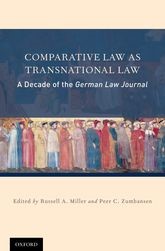ABOUT
An Open Access, Peer Reviewed Forum for Transnational and Interdisciplinary Encounters with Comparative, European & International Law
When the founding editors of the German Law Journal, Russell A. Miller and Peer C. Zumbansen, were working as clerks at the German Federal Constitutional Court, they sensed that lawyers around the world were increasingly coming into contact with other laws and legal systems. But legal practitioners and scholars had few possibilities at the time to reflect on this enriching transnational dynamic. Desiring to strengthen transnational reflection in legal scholarship and practice, they set up a bi-weekly newsletter on German constitutional law for an English-speaking readership. From there it did not take long for the German Law Journal to emerge in 2000. In line with the spirit of innovation, cooperation, and openness that had nurtured its foundation, the German Law Journal became an online-only, open access, peer-reviewed journal.
Today, the German Law Journal has secured a place among the world’s leading academic forums concerned with transnational law. The numbers make that clear. Measured by its impact factor, the German Law Journal is the leading “online, peer-reviewed” law journal of any subject matter; the second-ranked journal of any format covering European law; and the leading German-based law journal (online or in print). Google Scholar Metrics rank the German Law Journal third in the category “European Law” and tenth in the category “International Law.”
Other numbers and anecdotes tell a deeper story of success. The Journal now has a no-fee subscriber list of more than 5,000 readers. Its articles regularly attract hundreds of downloads in the first month of publication and thousands of downloads in the first year. The Journal has published many leading scholars, commentators, and practitioners in a wide range of law-related fields. In 2009, the Journal’s 10th anniversary was celebrated by the German Federal Ministry of Justice with a special event. And the GLJ was the only journal identified by name in the German Council of Science and Humanities’ influential report on “The Prospects for German Legal Scholarship”. Finally, the Journal is now regularly cited in decisions of the German Federal Constitutional Court.
Fundamental to the Journal’s success has been its commitment, from the very beginning, to opening up access to scholarship and research. The German Law Journal pioneered this approach, which is now emerging as the standard across disciplines. The Journal’s content always has been – and always will be – freely available online.
Despite its name, the German Law Journal has never had an exclusive focus on German law and legal culture. Rather, the “German” in German Law Journal stands for the conviction that awareness of one’s cultural imprint is indispensable for productive and critical work in transnational law. Hence, the Journal covers developments in German law, European law, international law, and comparative law. The Journal has also been innovative in other ways. It has, for example, established a strong reputation in collecting papers on topical issues, such as important rulings by the German Constitutional Court or the European Court of Justice. It is also emerging as a forum for cross-disciplinary and inter-disciplinary research, which often takes a thematic approach. The German Law Journal’s Special Issues , published about three times a year, epitomize this thematic agenda.
The German Law Journal is the product of a collaborative, widespread, and international effort. The editors in charge of developing the Journal’s content, including the peer-review of submissions, work at many different universities in numerous countries. The anonymous peer-review of all unsolicited manuscripts, introduced in 2003, is thorough and results in the rejection of more than 85% of all submissions. Guest editors of Special Issues include not only established members of the legal and related disciplines, but also “rising stars” at earlier stages of their careers. At the home institution of its editor-in-chief, Washington & Lee University School of Law, the Journal is supported by the untiring work of student editors who provide native-language editing and invaluable help with the Journal’s production and administration.
In short, the German Law Journal has become a dynamic and engaging forum for comparative and interdisciplinary research and commentary. It has been created and raised in an innovative, cooperative and participatory spirit, and will always continue its commitment to these values. We hope you will enjoy the German Law Journal … and join us in its work.
Comparative Law as Transnational Law
To mark the Journal’s 10th anniversary, Oxford University Press published a thematically curated selection of some of the impressive content the GLJ had published in its first decade. The aim was to showcase the Journal’s disciplinary and geographic breadth. The collection also reveals the range of experience of the Journal’s contributors. On one hand, the collection features articles and commentary from Constitutional Court Justices and world-renowned scholars. On the otherhand, there are a number of contributions from scholars at earlier stages of their careers. A lesson to be taken from this is that the Journal, above all, has been committed to publishing only the highest-quality scholarship, without resorting instead to proxies for quality.
But the book’s content also seeks to advance an argument about the inevitability of—as well as the difficulty and the responsibility associated with—a life in transnational law. The Journal’s founding editors, in their introduction to the volume, explain that the GLJ is meant to document as well as model a profoundly transnational approach to the law, what they refer to as “lived transnational law.”
The Allegory of Good Government
The German Law Journal’s website has always featured some version of Ambrogio Lorenzetti’s fresco The Allegory of Good Government (completed between 1338 and 1340), which can be seen in the Palazzo Publico in Siena, Italy. Lorenzetti (ca. 1290-1348) worked most of his life in Siena, where he eventually died of the plague. The upper-right portion of the fresco contains allegorical personifications of faith, charity, and hope. The upper-left portion of the fresco contains representations of peace, fortitude, and prudence. In the middle, the state (king) is depicted along with the three virtues of good government: magnanimity, temperance, and justice. In the far-left of the fresco one finds Justice herself, dividing on her scales the work of restoration and retribution. These powers sit upon a foundation of citizens, themselves linked to the executive and the judiciary with a connecting cord. For centuries Lorenzetti’s Allegory has provided inspiration for scholars and policy-makers. It inspires the work of the German Law Journal, too, by representing systems’ interconnectivity and interdependence, a reality that calls us to a transnational and interdisciplinary approach to the law.



